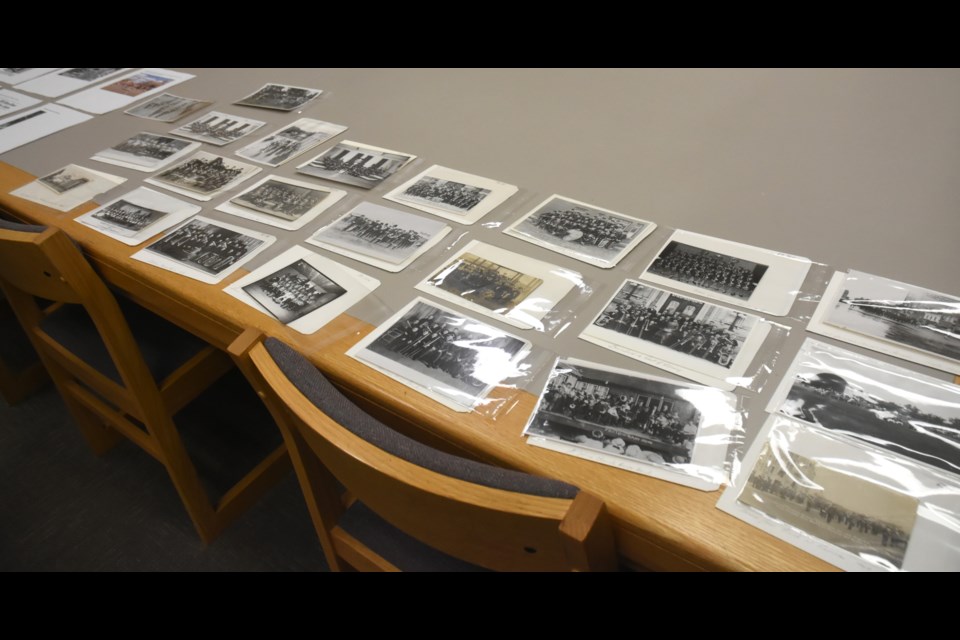MOOSE JAW — It’s been 30 years since downtown Moose Jaw was filled with marching band students, and the only way to see that area filled with interested onlookers is through archival photos.
Luckily, the Moose Jaw Public Library’s archives department has hundreds of photographs from decades ago of groups that contributed to the community’s nickname of “The Band City.”
Many of those pictures — along with scrapbooks of newspaper clippings — were on display recently during an open house to celebrate the 20th annual Saskatchewan Archives Week.
Janie Fries, chairwoman of the Moose Jaw Band and Choral Festival committee, was present to discuss the community’s musical history. She has spent many archival hours researching the organization — formerly known as the Moose Jaw Kinsmen Band Festival — while her experience with the event stretches back 59 years to when she played the brass French horn as a youth.
Aside from eight years living elsewhere, she has been continuously connected — as a student, teacher, volunteer, and now chairwoman — with the festival.
The festival began on May 20, 1950, and featured 11 groups performing at the former exhibition grounds, where the Town ‘n’ Country Mall now is. Although there was no parade down Main Street Hill, there was still a march in the downtown core.
“And … (it) wasn’t even called a festival. It was a band contest. So everybody got marks, and everybody got trophies and medals,” said Fries. “And I think right from the beginning, they had solos and small groups … .”
One highlight of the Kinsmen Band Contest was the musicians had the honour of “baptizing” the Civic Centre — the legendary Crushed Can — when it opened in 1959. With a chuckle, Friese said the venue had “terrible acoustics, but … nobody cared.”
Fries recalled performing every year starting in 1966, including playing solos when she had the opportunity. Moreover, the musicians marched regularly and sweated often because it was hot. The grounds of the former exhibition site were also uneven, so musicians’ mouthpieces continually jabbed them and left fat lips.
In 1967, Bobby Gimby, “Canada’s pied piper,” visited Moose Jaw to help celebrate the country’s centennial. A picture from the Times-Herald shows him standing in a crosswalk playing a hunting horn.
“He wrote what was called the ‘Canada Song,’ which kids sang all the time for the centennial. So, we were really fortunate to have him at the festival,” said Fries.
Organizers added choral in 1976, and Col. Harland David Sanders, the founder of Kentucky Fried Chicken (KFC), attended and presented a $10,000 cheque for the first awards. He came after Chic Wray, who owned the Moose Jaw KFC, approached the head office looking for sponsorship.
In 1982, more than 20,000 people found a space on Main Street to watch dozens of bands perform during a roughly three-hour parade. However, 1994 was the final parade with 12 groups, so the next year, bands performed on street corners and people could walk around and listen.
Fries noted that if Russ McKnight hadn't stepped forward to lead the festival in 1994, that could have been the event's last year, considering the Kinsmen Club had withdrawn its sponsorship and was refocusing its efforts on Telemiracle.
The committee later moved the concerts to the Crescent Park Amphitheatre, while around 2000, they moved the festival to Thursday and Friday nights because groups weren’t registering for Saturday, which threatened the event’s existence.
“Those Saturday concerts were a lot of fun because the clinicians would come in and sit with them,” said Fries. “But if you’ve only got one group … then it’s not worth it.”
Today, the festival runs from Monday to Thursday in the evenings.
Students love playing at the festival, especially with the pandemic over and people able to attend events, said Fries. Furthermore, the committee enjoyed holding the event at a few downtown locations because all the amenities and attractions were there and it was walkable. However, the sale of St. Andrew’s United Church forced organizers to move the festival to Hillcrest Apostolic Church because it had rooms for groups to practice and perform.
“I’m really, really glad that it’s still going and it’s still viable, and that it’s evolved and changed with the times to help make it viable,” said Fries, adding that the community has helped make the event a success over the decades by being so welcoming of the students.
Editor's note: This article has been updated to include more information about the festival's history.




